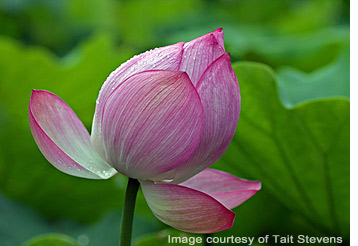
The Water Lotus is sure to be the star of any water garden, it occupies. Water lotuses are exotic, majestic and dramatic. They flourish in the sunlight and fill the water garden with vibrant colors and exotic fragrances. A relative of the water lily, the water lotus will spread across the pond and compete for its attention. More than one lotus plant can look overwhelming in smaller ponds, so pond owners must choose the correct variety for the area they have available. General Information on LotusesThere are two different species of lotus: Nelumbo lutea are the Native American species and Nelumbo nucifera are native to the Orient, the Philippines, north Australia, Egypt, and the Volga River delta at the Caspian Sea. Like any aquatic plant, there are many different varieties. They come in a wide range of sizes, varying in height from 18 to 60 inches. The smaller lotus varieties can reach 8 to 12 inches tall with leaves 2 to 3 inches in diameter. These so-called “dwarf lotus” varieties can grow wonderful flowers up to 1 foot wide, resting atop stems that reach 6 feet above the water surface. Others grow 6 to 8 feet tall with leaves 18 to 36 inches in diameter. Miniature lotus leaves can unfold 6 to 16 inches tall on stems 2 to 4 feet long. The larger ones may even grow 2 feet wide and 6 feet tall. The pointed lotus bud emerges from the water garden on a stem 2 to 6 feet tall, unfolding its full, fragrant flower above its exotic foliage. Their beautiful flowers can grow up to a foot wide and come in a variety of colors – white, pink, red, yellow or cream. Though they look tropical, these aquatic plants are actually perennials. Lotuses love – and need – the sun and heat in order to reach their fullest potential. Though they certainly are able to bloom in partially shaded situations, the water temperature must be warm enough for them – between 75 and 87 degrees. The lotus will meet its enemy, however, in humidity. This aquatic plant will not fare well in humid conditions. Water Lotuses thrive in warm climates, requiring at least 5 to 6 hours of sun a day. They will grow with less, but they will not bloom as well, and their foliage may be stunted. Cloudy, cool areas such as the Pacific Northwest do not provide a hospitable environment for these sun-worshipping aquatics. Because of their large leaves, lotuses are so-called heavy feeders, therefore requiring so much of the sun’s attention. In order to truly thrive, they need full, day-long sunlight. Planting and Maintenance
Many people find the lotus an intimidating aquatic plant to handle. They are, however, quite simple to grow – almost as easy as water lilies, though they do require more care and patience. The banana-shaped roots of the lotus are called tubers – and they’re very fragile. Handle them with extreme care so as not to break off the eye, or the pointed tip of the tuber from where the leaves will eventually grow. It is important to know the lotus will not grow properly if the eye is damaged in any way. Warmth is essential to growing the lotus from the very beginning. Keeping the tuber too cold may cause it to rot before it takes root, so take care to keep it warm. It helps to keep the tuber floating in pond water for two weeks (a little less is okay) in a warm, sunny place before planting it. Once the lotus tuber is ready for planting, you must choose a location. It should be planted in a sunny spot, away from flowing water, and in a space that is proportional to the size and number of lotus to be grown. Larger lotus varieties need large areas in pond or water gardens, while smaller lotus varieties will thrive in smaller areas. Next, choose a pot. Because lotuses grow to the size of the area in which they are planted, containers will prevent them from sprawling out of control and taking over, as would happen if they were planted loose in any pond or water garden. On that note, choose the size of the container carefully, as they will size themselves to their container. Use the deepest pot possible to decrease the chances that they will jump over the side and grow further out into the pond than intended. Furthermore, because of their fragility, it is best to plant them in large, round containers with plenty of room so they don’t get wedged or jammed in any corners, in turn stunting their grown or worse – killing them. Use the largest, roundest container that will fit in the desired space. Standard-size lotus grow well in containers that are 3 to 4 feet in diameter, while smaller or dwarf-size lotuses can be planted in smaller, bushel-size vessels. Again, though, the largest and deepest possible pot is preferred. Fill the chosen pot with soil, leaving 3 to 4 inches remaining at the top. The best possible soil is amended soil, or soil with material added to it to improve its physical properties. This soil creates a better environment for the roots to grow. Then cover the soil with 2 to 3 inches of sand and slowly fill the container with water. Now it’s time to plant the tuber. Set the tuber on the surface of the filled pot – embed it slightly in the sand, then weigh it down with stones. This will prevent the tuber from floating out of the dirt until the roots have developed. Burying the tuber in the sand and soil can cause the tuber to rot, so take care to only embed it only slightly. After this, the lotus will basically plant itself, turning downward into soil mixture and then growing as it should. Just be sure to keep the aquatic plant in a sunny area. The plants will grow quicker if they are kept in heated water. Leaves will begin to come up once the tuber has taken root. The warmer the room the tubers begin in, the quicker they are likely to appear. Once the container is filled with the sand and soil and the tuber is secured in place, you can lower it into the water garden or pond. The container should be 6 to 12 inches below the water’s surface – anything less than that could cause the plant to tip or bend over as it grows taller. Lotuses are slow-growing aquatic plants at first. The new leaves, or young leaves, will start out by floating on the surface. This usually takes place 2 to 3 weeks after being planted in mid-spring. At this point, you can start feeding the plants fertilizer tablets designed for water gardens, if you desire. These floating leaves will look like giant lily pads, and will be followed by curled-up aerial leaves. The sturdy leafstalks will soon follow that. These leafstalks will lift the foliage above the water, several inches to several feet above the water’s surface. Lotuses do not bloom as early in the season as do their relatives, the water lily. They need 3 to 4 weeks of temperatures above 80 degrees to begin blooming. They often do not produce their first blossoms until their second summer, after they have been transplanted. It is in this second year that they begin to bear more flowers. It is possible, however, to bloom their first season with several weeks of sun and temperatures holding consistently in the 80s. In most parts of North America, they will begin to bloom in mid-June to mid-July and will continue to bloom on into autumn. Lotuses are day-blooming plants, opening early in the morning and closing by mid-afternoon. They completely close up at night. This bloom pattern continues throughout their lifespan, which is typically 3 to 5 days. On the third day, the petals begin to fall, leaving behind their seedpod. This seedpod is what allows more lotuses to keep growing. It is yellow at the time the flower first opens, though it eventually turns green. It expands in size once the petals have fallen until it is nearly twice its original size in diameter. Eventually, after about 6 weeks it turns brown. Once matured, it heads back to the water where it makes more lotuses and begins the cycle again. Throughout the season, the yellowed and yellowing foliage should be removed. All dead leaves found an inch above water should be removed, as well. They should be fertilized every 2 to 3 weeks throughout the growing season and should be heavily fertilized throughout the spring. As soon as flowers begin to show, the fertilizing should continue, but at a lower rate. Every 2 to 3 years, pond owners should completely rework the pot they grown their lotus in – emptying it out, clearing out the dead tubers, and adding new soil to start fresh. Once the weather begins to turn cooler and winter approaches, special care must be given to lotuses to ensure they will return the following spring. In the fall, carefully cut away all of the foliage off this splendid aquatic plant, as the lotus begins slowing down for the winter. In colder climates, lower the pan deep to the bottom of the pond to be left there over winter. This will allow it to keep over winter nicely, so long as the pond doesn’t freeze to the bottom. In warmer climates, however, the lotus can be kept in the water garden throughout this colder season. Either way, the goal is to keep the lotus cool and dormant without freezing it. Come springtime in those colder climates, once the new leaves begin to emerge, move the container up to its proper, shallower depth of the water. |


